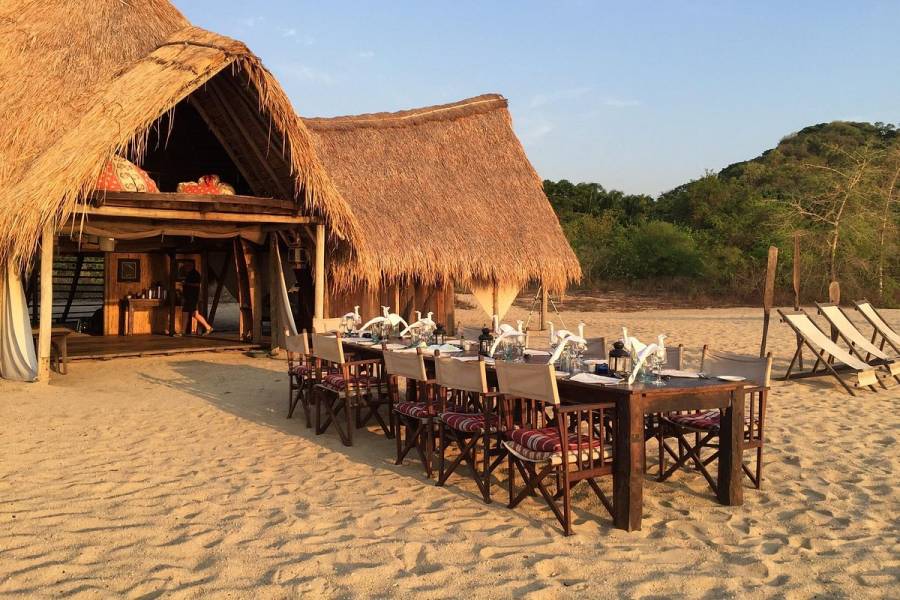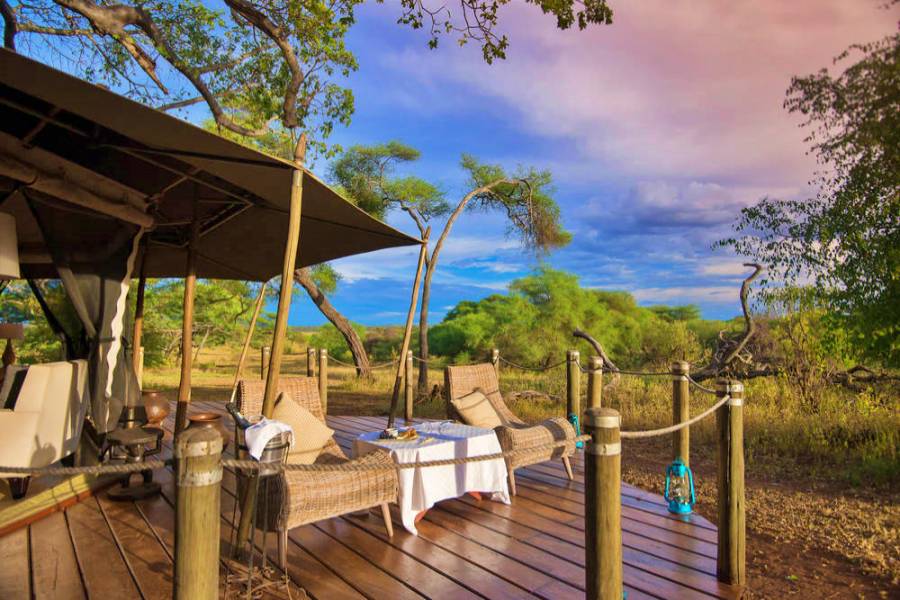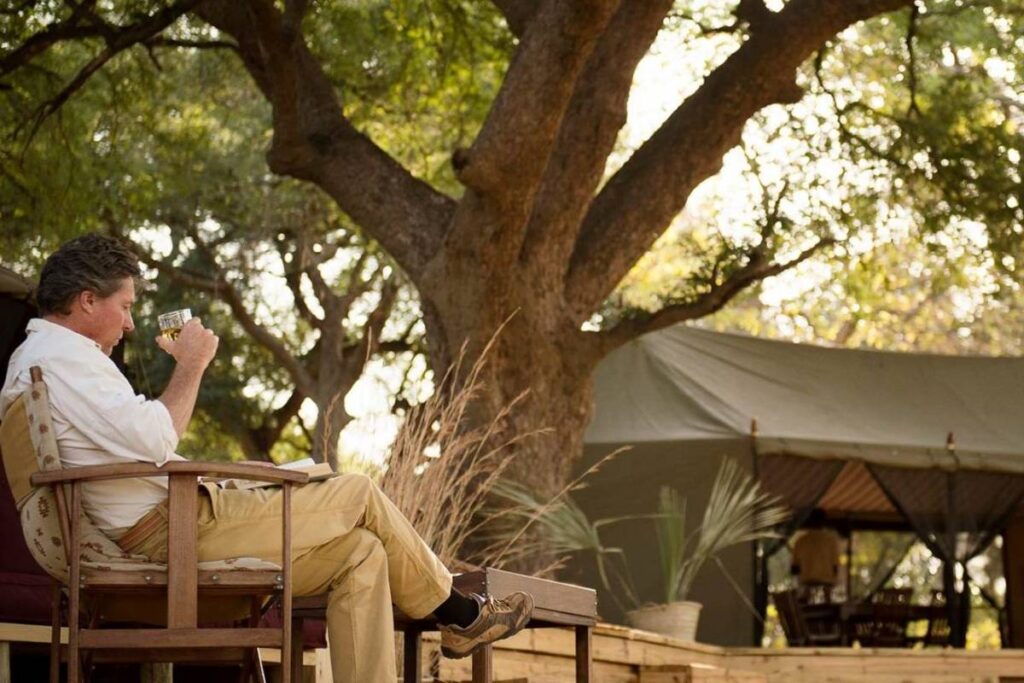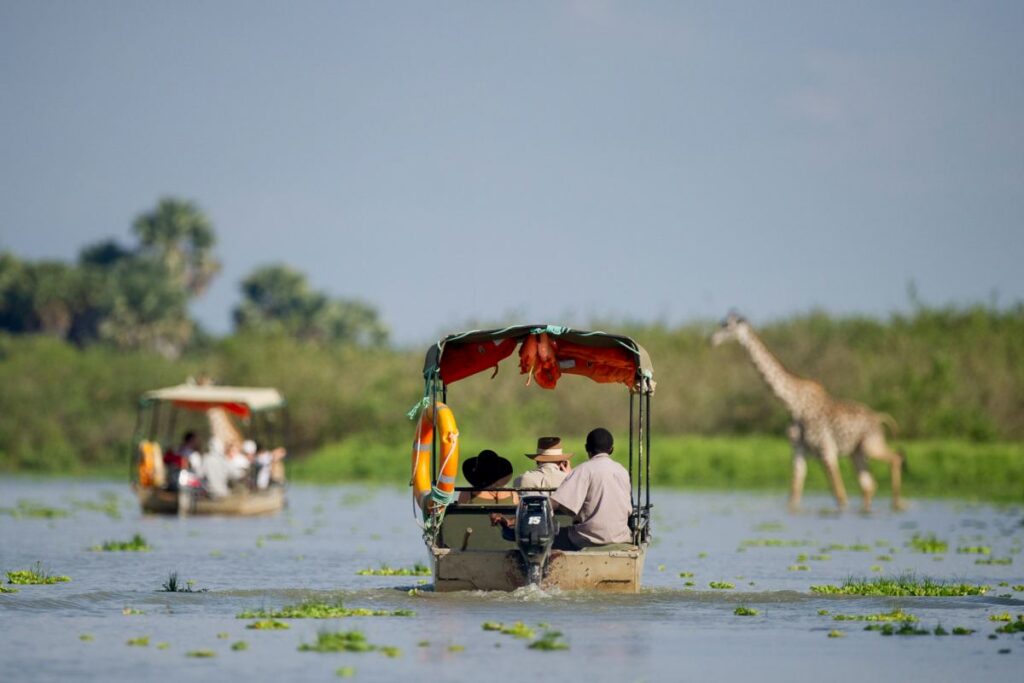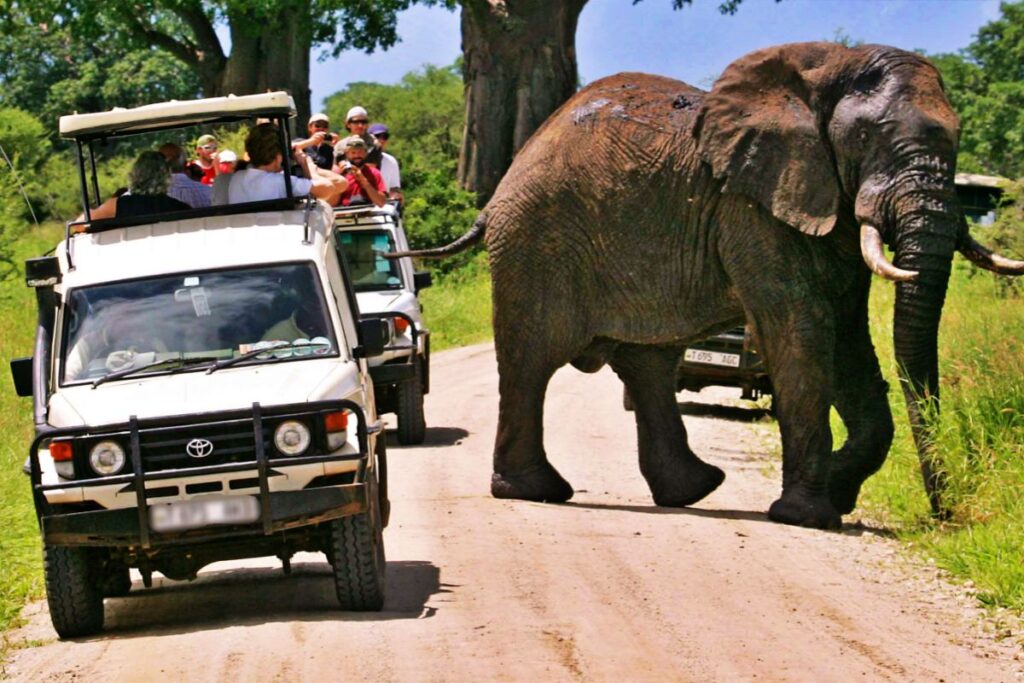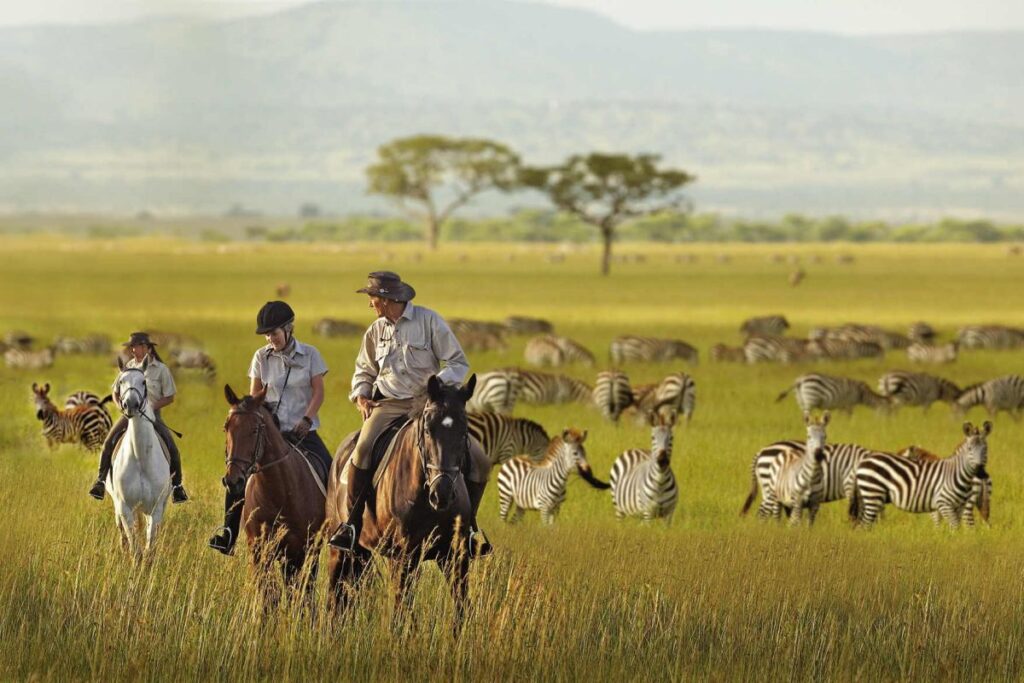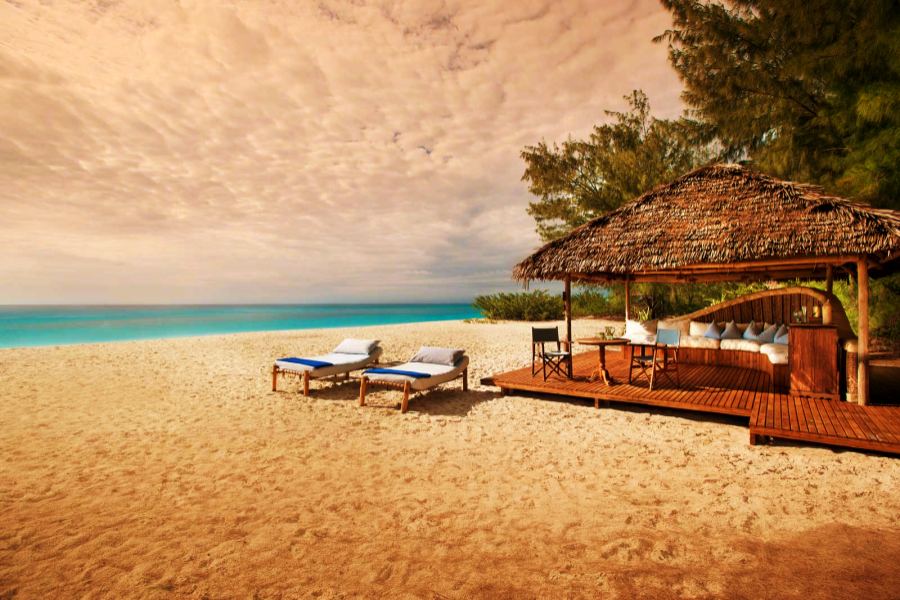Tanzania Safari
From the Wildebeest Migration to the Big 5 and Tropical Beaches
Safari happens almost everywhere you look in Tanzania. It’s been a way of life in East Africa’s second-largest country for decades. Few destinations in Africa can rival Tanzania’s diversity of wildlife and landscapes. From the classic savannah destinations of the Serengeti, Tarangire and Ngorongoro Crater to the beaches and coral reefs of Zanzibar, a Tanzania safari delivers one massive experience after another. And that’s before you discover the off-the-beaten-path gems like chimpanzee trekking in the untouched rainforests of Mahale and Rubondo, or crowd-free game viewing among the beautifully wild and unique landscapes of Nyerere (previously Selous) and Ruaha.
From incredible year-round game viewing to the Wildebeest Migration and tropical beach finales, here are some of our best reasons to go on a Tanzania safari:
Witness the Great Wildebeest Migration
Hardly any other destination on Earth can offer a wildlife encounter to match the annual Wildebeest Migration. Forming the centrepiece of most inaugural Tanzania safari itineraries, the Migration is a mind-blowing display of nature at her most extraordinary. About 2 million wildebeest, zebra and antelope run the gauntlet of predators as they migrate around the Serengeti-Mara ecosystem in search of fresh grazing. This awe-inspiring event is one of the last mass terrestrial animal movements left on the planet – the herds are so big they can be observed from space!
- The Serengeti National Park – Tanzania’s flagship conservation area – hosts the bulk of the Migration.
- Mobile camps move regularly to stay as close to the herds as possible.
- Some accommodations offer easy access to river crossing points.
Note: availability of well-located safari camps between June and October (river crossing season) is limited. If you want front-row seats to the dramatic river crossings, you should book your Tanzania safari at least a year in advance. Or opt to go when the herds give birth and graze their way across the plains, which is just as impressive to see but easier to guarantee – plus the tourist crowds are fewer. Chat with one of our Africa Safari Experts to plan your trip to coincide with the movements of the herds.
See the Big 5 in an Ancient Volcano
The Ngorongoro Crater was formed around 2.5 million years ago when a giant volcano exploded and collapsed on itself. Now an enclosed ecosystem and World Heritage Site, the Crater is the best place in East Africa to see the Big 5. Measuring in at around 600 metres (1 970 feet) deep, the Crater’s floor covers about 260 square kilometres (100 square miles). Its surprisingly diverse habitats support around 30 000 animals.
- East Africa’s most reliable Big 5 sightings.
- One of the Seven Natural Wonders of Africa.
- Home to some of Africa’s densest large mammal populations.
What travellers most enjoyed about Tanzania
Best Places to Visit in Tanzania
From witnessing millions of wildebeest, zebra and other antelope traverse the plains of the Serengeti to ascending to the snow-capped peak of Mount Kilimanjaro or sipping chilled drink on the white-sand beaches of Zanzibar, Tanzania offers travellers some of the most diverse safari experiences in Africa.
A vibrant and beautiful country with exceptional parks and reserves, Tanzania is blessed with the winning combination of unparalleled game viewing and dazzling tropical beaches. Because Tanzania is so vast (almost 1.5 times the size of Texas), it helps to divide the country’s major holiday destinations into four areas:
- Northern Safari Circuit – the most popular Tanzania safari route comprising the Serengeti, Ngorongoro, Lake Manyara, Tarangire and Kilimanjaro.
- Tanzania Coast and Islands – the country’s beaches, especially those on islands like Zanzibar, are breath-taking and very accessible.
- Southern Tanzania – includes the wonderfully wild and underrated Nyerere (previously Selous) and Ruaha, some of the best-kept Tanzania safari secrets.
- Western Tanzania – head to the far-flung corners of Katavi and Mahale for the ultimate off-the-beaten-path Tanzania safaris.
Ngorongoro Crater: Haven for the Big 5
Take about 30 000 animals and place them inside the crater of an extinct volcano. Add wetlands, forest, grasslands and some out-of-this-world cliff-top accommodation, and the result is the Ngorongoro Crater. This superb Tanzania safari destination offers excellent game viewing in an unbelievably unique setting. It’s renowned for delivering the easiest and most reliable Big 5 sightings in East Africa, and is provides what is arguably the best safari in Tanzania.
Serengeti National Park: A Safari Superstar
Synonymous with safari, the Serengeti is where to go in Tanzania for game viewing at its most dramatic. Hosting the lion’s share of the Wildebeest Migration (from about January to September), the Serengeti’s sheer size, accessibility, top-quality lodges and camps, and year-round abundance of wildlife make it one of the best safari destinations in Africa. It’s also a regular stop on the best Tanzania safari tours.
Tarangire National Park: An Elephant Empire
Close to Lake Manyara and the Ngorongoro Crater, Tarangire is worth much more than the usual day visit. During the June to October dry season, animal – especially elephant – concentrations along the Tarangire River are among the highest in the country. The park’s bird count of more than 500 species means that a visit here is one of the most rewarding Tanzania safaris for twitchers, while its full range of large predators complete the appeal. Tarangire is a beautifully diverse wilderness featuring riverine forest, huge swamps and open woodlands that include Africa’s iconic baobab trees.
Lake Manyara National Park: Home to Tree-climbing Lions
Part of Tanzania’s famed Northern Safari Circuit, Lake Manyara offers easy game viewing in a beautiful setting. The park is home to a good range of heavyweight species, including buffalo, hippo, giraffe, elephant, leopard, and its famous tree-climbing lions. Lake Manyara is an exceptional bird-watching destination. You’ll often see flocks of pelicans and flamingos in the middle of the lake, and the floodplains, woodlands and evergreen forests are equally vibrant.
Zanzibar and Tanzania Islands: Indian Ocean Bliss
Crown your East Africa safari experience with a stay on Tanzania’s Spice Island: Zanzibar. Perfect for both families and honeymooners, it’s where to go in Tanzania for glorious beaches and coral reefs, dhow (traditional boat) trips at sunset, and exploring fragrant back-street markets. Tanzania’s other Indian Ocean islands won’t disappoint either. Pemba, Mafia and Chole are superlative beach holiday destinations with superb diving, exclusive boutique accommodation and all the indulgent pampering you could wish for.
Ruaha National Park: A Hidden Gem
Ruaha’s wild and unbridled character is what sets it apart from other safari destinations. This hidden gem is Tanzania’s biggest national park and there are only a handful of safari camps despite its size. You won’t see other tourists around – only a plethora of animals like buffalo, giraffe, kudu, sable, roan, lion, cheetah and leopard. It’s home to Tanzania’s biggest elephant population and a stronghold for rare African wild dogs.
Selous Game Reserve: A Wild Dog Sanctuary
Selous (pronounced ‘suh-loo’) is Africa’s largest game reserve – bigger than Switzerland. Its lifeblood, the colossal Rufiji River, forms an intricate network of channels, swamps and lakes from which one of East Africa’s most magnificent ecosystems is born. Buffalo, hippo, crocodile and lion thrive here, while the reserve is also one of Africa’s most important sanctuaries for endangered wild dog. Don’t miss a boat safari, guided walk or fly-camping excursion is this breathtaking wilderness.
Best Time to Go to Tanzania
Most safari areas in Tanzania enjoy warm days and cool evenings year-round. While temperatures drop to below freezing on Mount Kilimanjaro and Mount Meru, the country’s Indian Ocean coast and lakeside regions are hot and humid.
Tanzania has two distinct rainy seasons: April to May (the ‘long rains’) and November to December (the ‘short rains’). Generally, the country’s main rainy season (the long rains) produces tropical downpours in the afternoons and many safari camps close. The short rains season sees the occasional brief shower, but safari camps stay open and game viewing is good.
The best time for a Tanzania safari will depend on where you want to go and what you want to see. For first-time safari goers, the best time to go to Tanzania is usually during the dry season, as wildlife is easier to track and spot. Whether you’re visiting Tanzania for the first time, understanding the difference between the safari high season vs low season is a great place to start.
Tanzania Safari Travel Advice
Tanzania Safari Travel Advice
At African Landmark Safaris, we live and breathe providing our clients with unbiased advice and extraordinary safari experiences. Our Africa Safari Experts are permanently based in Africa, are well travelled, and have extensive first-hand knowledge of the destinations they recommend. They regularly inspect new lodges, experiences and activities to ensure these offerings meet our clients’ expectations.
There’s nothing like up-to-date, relevant travel information direct from someone who’s been there.
Tips for Planning Your Tanzania Safari
- Plan your timing carefully: if you want to see the Wildebeest Migration on your safari or enjoy the best beach weather in Zanzibar, make sure your itinerary matches your travel wishes.
- Book early for high season: Tanzania’s sought-after safari destinations and well-located camps at Wildebeest Migration hotspots get booked out early, often a year in advance.
- Choose your activities: morning and afternoon game drives are standard safari activities, but excursions like night game drives, guided bush walks and hot-air balloon safaris are only allowed in certain areas or camps.
- Expect other visitors in high season: Tanzania’s heavyweight national parks like the Serengeti, Ngorongoro Crater, Lake Manyara and Tarangire can attract a lot of visitors from about June to October. Consider visiting during low or Green Season (about November to March) if you want to escape the crowds and still enjoy great game viewing.
- Go private: if it’s exclusivity you want, then head for one of Tanzania’s private reserves. The accommodation is superb, game viewing is as good as the main parks, and extra safari activities (see number 3) are occasionally offered.
Money and Spending
Tanzania’s unit of currency is the Tanzanian Shilling, but our advice is to use US Dollars only – and in cash: credit cards and traveller’s cheques (although accepted in most establishments) incur transaction fees. ATMs are found throughout the major towns and cities in Tanzania, but not in the national parks and game reserves.
Note: US Dollar bills printed before 2006 are not accepted in Tanzania.
Tipping lodge staff and drivers/guides is customary for good service on a Tanzania safari, but check first to see whether a service charge has been added to your bill. Tipping is always in addition to the price quoted by your operator and the amount varies depending on the size of your group, the level of luxury of the safari and whether you thought an exceptionally good job was done. When travelling in the major Tanzania cities, a 10% tip is customary in restaurants and bars when a service charge is not included.
Read our blog for in-depth tipping guidelines or get in touch with one of our Africa Safari Experts for advice.
What to Pack
When packing for your Tanzania safari, light casual clothing in practical, neutral colours and a warm jacket for evening game drives are a safe bet throughout the year. For more on what to pack for a safari, refer to our Africa Safari Guide.
When visiting Zanzibar, it’s important for women to dress modestly in main towns out of respect for Muslim cultural beliefs. T-shirts that cover the shoulders, long skirts and capri pants are generally better options than tank tops and shorts. Beach wear and bathing costumes are acceptable on the beaches and in resorts.
Etiquette
Religious belief is strong in Tanzania, with Christianity and Islam dominating. Most Muslims live on the coast and in Zanzibar; visitors should be aware of the conservative nature of these destinations – especially Stone Town – and dress and behave accordingly.
Tanzanians are renowned for being friendly and harmonious people, however, it is courteous to ask permission before photographing people.
Flights and Getting Around Tanzania
Main International Airports
Kilimanjaro International Airport – Tanzania’s second international airport – serves the Serengeti, Ngorongoro Crater, Tarangire and Lake Manyara. However, you need to transfer to nearby Arusha Airport for charter flights to these safari destinations. International flights often arrive at Kilimanjaro Airport late in the day, so an overnight stay in Arusha is usually necessary.
Dar-es-Salaam International Airport – Tanzania’s main airport – is the gateway to the Indian Ocean coast and Zanzibar, as well as Nyerere National Park (previously Selous) and Ruaha National Park.
Regional Airports
Arusha Airport – the gateway to northern Tanzania’s safari airstrips – is located about 30 kilometres (18.5 miles) from Kilimanjaro International Airport.
Did you know you can book your flights through African Landmark Safaris? For more information and frequently asked questions, please see our Flights page.
Safari Vehicles
Guided road transfers and game drives in Tanzania are conducted in closed 4x4s with big windows and pop-up roofs, although visitors to destinations like Mahale will enjoy a boat transfer across Lake Tanganyika. Most safari destinations have extensive road networks and closed vehicles are therefore the norm when doing long-distance road transfers between airstrips, camps and lodges in Tanzania. A closed 4×4 game drive vehicle generally has three rows of seating and features a pop-up roof hatch that can be raised for game viewing and taking photographs.
Visa and Passport Requirements
Almost all visitors to Tanzania require a visa. You must contact the relevant issuing authorities in good time (ideally, several months in advance) to ascertain the entry requirements to Tanzania, and to arrange the necessary permits and visas. We strongly encourage all clients entering Tanzania via Kilimanjaro International Airport to obtain their visas online at Tanzania Immigration Department before arriving in Tanzania. E-visas can take 2 to 3 weeks to be issued.
Visitors to Tanzania must possess a passport that is valid for six months after the initial date of travel.
Best Tanzania Tours and Safaris
Our tried-and-tested Tanzania itineraries deliver once-in-a-lifetime experiences. Naturally, most of our Tanzania tours and safaris focus on the country’s fantastic parks and reserves like the Serengeti and Ngorongoro Crater. But we also have a great selection of tours to Tanzania’s lesser known yet underrated reserves like Nyerere (previously Selous) and Ruaha. Plus, the exotic Zanzibar and other Indian Ocean islands offer fabulous beach resorts. We recommend getting the best of both: combining a luxury Tanzania safari and a tropical beach getaway – it’s straightforward and easy to arrange.
Best Accommodation in Tanzania
Home to the Serengeti National Park, Ngorongoro Crater and a host of other superb parks and reserves, Tanzania is one of Africa’s classic safari destinations. And its accommodation options reflect this: luxury safari lodges, remote tented camps and popular safari hotels make up most of our recommendations.
Our selection of Tanzania accommodation showcases both luxury lodges and more affordable safari camps, ensuring that everyone gets a taste of this fascinating and diverse country. Tanzania also has some of East Africa’s most exceptional and indulgent accommodation – think private safari villas set in the most incredible wilderness locations.
Our Selection of Top Accommodation in Tanzania Includes:
- Mobile camps that follow the Wildebeest Migration’s movements.
- Properties perfect for families or groups travelling together.
- Superb luxury lodges that are tucked away for the most romantic safari honeymoon.
- Breath-taking beach lodges on tropical islands.
Browse our favourite Tanzania accommodations below or simply get in touch with one of our Africa Safari Experts to help you find the one that’s right for you:

